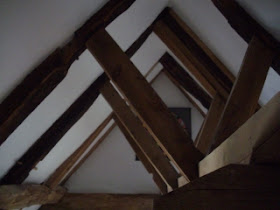We have been reading the blog of our friends Kyle and Maryanne who have been travelling across Scotland on their catamaran Footprint. Moving east through the Caledonian canal they experience the same weather as us whilst taking in the breathtaking Caledonian Canal scenery that we enjoyed last year. Their account has much detail of their day to day lives living aboard the boat whilst travelling about, reflecting our own existence.
They talk of the 'luxury' of a hire car taken for a day so they could visit some places that might otherwise be difficult to get to, a telling comment in this car-mad age when most people would not regard the car as any sort of a luxury. We recently did the same thing on Mull, hired a car for a day so that we could see as much of the island as we wanted with the advantage of being able to stop as we pleased when something caught the eye. (It is worth adding that car hire, like many other aspects of life here, is handled in a casual way. 'You say you've had no accidents or convictions so that's fine by me...').
Our day proved to be sunny and cool but clear and £35 well spent. It was one of those rare days when the air positively gleams and you feel you can reach out and touch objects twenty miles or more away. In total we drove about 100 miles which, to anyone who knows Mull, is something of an achievement.
Apart from one short section along the shore between Craignure and Salen, Mull's roads, despite being used by the island's regular bus services, are wide enough only for one vehicle. Frequent passing places and basic politeness make it all work, that and a general lack of haste. Few of our car's five forward gears saw use.
In a heritage exhibition centre near Dervaig there are painstakingly excellent models showing what the stone and iron age dwellings might have looked like with information on how it is thought people lived. There is little here to explain the standing stones but models of the 'black' houses, so called not because of the wood smoke which perpetually filled the chimneyless interior but because of the similarity in pronunciation between the Gaelic words for 'black' and 'thatched', give a clear impression of hardships people lived under. Such apparent poverty left no room for sympathy from the landowners, both English and Scottish, who in the 18th and 19th centuries evicted so many people from these lands so that intensive sheep farming could be introduced. Who can imagine what Mull would be like today had these events not occurred.
One highlight of the day was a visit to Carsaig on the Ross of Mull, the southern peninsula that points westward towards Iona. Here we left the car and took a walk under the same thousand foot cliffs that we sailed past last summer. The geology of this whole area is amazing. You get basalt columns mixed with volcanic and sedimentary rocks, some of which are crammed with ancient sea shells, sharp edges of ancient mussels and limpets still sticking out.
Above us were wild goats living in the tiny strip of land between the sea and the cliff, most of which slopes at forty-five degrees, and then higher still the golden eagles soar. There are supposed to be more than 100 of these creatures living on Mull so they are not an uncommon sight. They just float about effortlessly looking more like small aeroplanes than birds. Crows and seagulls will fly up and mob them, but cautiously and with no great effect. They are top predators here and they know it.








